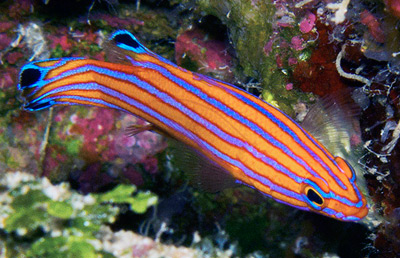Ask any group of marine fishkeepers to name their most sought-after species—the fishes they’d really love to own if money and availability were no object—and most of them will likely place the candy basslet (Liopropoma carmabi) somewhere close to the top of that list. Ah, but despite its stunning good looks and very manageable size, L. carmabi, a deepwater species hailing from the tropical western Atlantic and Caribbean, is rarely available in the hobby and fetches a daunting price on the few occasions it is offered for sale.
I’ve only ever seen this species in photos and videos (oddly enough, it seldom finds its way into Toledo-area fish stores), but if those depictions are anywhere near accurate, L. carmabi truly is a jewel of a fish. It’s probably all for the best that specimens never materialize locally, however, as I’d probably have to sell my firstborn to afford one.
Physical traits
Reaching only around 2½ inches, the candy basslet is a relatively diminutive species. But there’s nothing small about its eye-dazzling coloration. This fish is orange overall with horizontal lavender stripes outlined in red adorning its flanks. It also sports three prominent black ocelli (eyespots) circled with lavender—one on the trailing edge of the dorsal fin and two on the caudal fin.
Other Liopropoma species with somewhat similar color and patterning are sometimes sold under the common name “candy basslet,” for example L. rubre (better known as the Swissguard basslet) and L. swalesi (aka Swale’s basslet). However, as any hobbyist who covets the candy basslet will tell you, these congeners simply can’t hold a candle to L. carmabi from the eye-candy standpoint.
Feeding
Based on accounts I’ve read—not, regrettably, personal experience (which I could acquire if someone would just buy me one!)—L. carmabi will accept a variety of small meaty food items, such as mysis shrimp and finely chopped clams, shrimp, etc. Whether it takes to a captive diet readily or tends to be a reluctant feeder initially, I cannot say.
Housing
The candy basslet tends to be secretive, spending most of its time hiding in caves/crevices or under ledges in the rockwork. So, any tank housing one should be aquascaped accordingly—with lots of nooks and crannies in which to refuge. Subdued lighting is also preferable for this deepwater resident.
Owing to the candy basslet’s shy nature, it’s apt to get “lost” in a large system with lots of active tankmates—which sort of defeats the purpose of spending an arm and a leg (“a nominal egg” for you New Yorkers) to acquire one. Thus, it might be best to keep a candy basslet as the star inhabitant of a smaller system.
Compatibility
L. carmabi should get along with most other peaceful fish, though if I were choosing tankmates for one, I would be inclined to avoid highly energetic species, even non-aggressive ones, as I suspect they would dissuade it from emerging. I’d also probably avoid keeping conspecifics together in the same tank unless I had an established pair.
As a reef aquarium candidate, L. carmabi is completely harmless toward sessile invertebrates, but keep in mind that in an intensely illuminated aquarium, a specimen may tend to make itself scarce until lights out.



